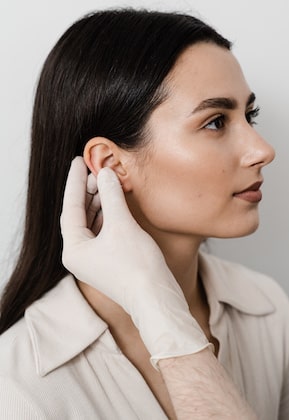
The look of the ears can be a source of anxiety and embarrassment for many people. They might think their ears are too big or stick out too far from their head. In addition, they could be self-conscious about the look of their ears which might make them stay away from some events and gatherings. Thankfully, there is a solution to the issue of protruding ears known as otoplasty. Keep reading to learn why the ears of a person stick out and how otoplasty alters the look of errant ears.
If the ears of a person stick out from the head at a length of more then two centimeters, which is about three-fourths of an inch, they are considered to be protruding ears. When it comes to any type of deformity to the ears, many of these deformities are present at the time of birth. The main reasons for ears that greatly stick out from the head include the presence of too much cartilage in the concha AKA the part of the ear that is bowl-shaped which pushes the ear away from the head or an underdeveloped antihelical fold which can cause the outer rim of the ear, which is known as the helix, to stick out.
 Otoplasty is a cosmetic surgery procedure that is able to adjust the shape, size, or position of the ears. It can be performed on patients who feel their ears protrude too far from their head and also on patients who are looking to correct a structural abnormality to the ears. It can also help patients with ears that have an abnormal shape due to an injury or trauma to the ear as well as someone who has a structural defect to the ears that has been present since birth.
Otoplasty is a cosmetic surgery procedure that is able to adjust the shape, size, or position of the ears. It can be performed on patients who feel their ears protrude too far from their head and also on patients who are looking to correct a structural abnormality to the ears. It can also help patients with ears that have an abnormal shape due to an injury or trauma to the ear as well as someone who has a structural defect to the ears that has been present since birth.
Otoplasty, AKA cosmetic ear surgery, is performed on the portion of the outer ear that is visible and this is known as the auricle. The auricle starts to develop before birth, and it is made of folds of cartilage. It continues to develop for some years after a person is born. If the auricle is not able to develop properly, a patient can have otoplasty to make changes to the ears.
There are multiple types of otoplasty techniques, and the desired result of the patient influences the choice of treatment. Otoplasty options include:
In addition to those who want to change the size, position, or shape of their ears, children who are five or older are good candidates since the ears have reached ninety percent of their adult size by that point. There are also some patients who already had otoplasty and are not happy with the results, so they want to have revision otoplasty.
If an issue with the ears is identified in the first few weeks of life for a baby, the doctor can place ear molds on the ears of the baby in order to reshape them without having surgery.
For older children, teenagers, and adults, otoplasty is an outpatient procedure that can take anywhere from one to three hours to perform. The length of the surgery depends on the amount of work that the surgeon will need to perform.
Otoplasty usually starts with the creation of an incision on the back of the ear or inside the folds of the ear. The surgeon will then make the changes to the ear, and this can include the removal of skin or cartilage, the grafting of cartilage to the ear or folding and shaping the cartilage through the use of permanent stitches. Once the changes to the ear are made, any incisions will be closed.
The patient will have a dressing placed over the ears after the surgery. The dressing should be kept dry and clean, and the person should not sleep in a position where they are on the ears. In addition, they should avoid scratching at the ears. The ears might experience some soreness, swelling, and bruising along with some numbness, tingling, and itchiness.
The dressing will come off after a week and then the patient will wear an elastic headband for four to six weeks.
The ears will start to gain an improved look after two or three weeks, but it can take up to a year to see the final results. Once the final results are visible, the results of otoplasty should last a lifetime.
- MA